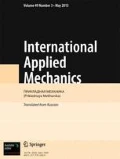The inversion symmetry of the components of the displacement vector and stress tensor in the solution of the first boundary-value problem of elasticity for a half-space is studied. The case where one component of loading on the half-space boundary has inversion symmetry and the other two components are equal to zero is considered. Inversion symmetry is also studied for the mixed problem where normal forces act and tangential forces are equal to zero one part of the half-space boundary, while the conditions of smooth contact are prescribed on the other part, and the problem of the torsion of an elastic half-space with tangential stresses given on its boundary.
Similar content being viewed by others
References
Yu. A. Antipov, “Exact solution of the problem of indentation of a ring punch into a half-space,” Dokl. AN USSR, Ser. A: Fiz.-Mat. Tekhn. Nauki, No. 7, 29–33 (1987).
L. A. Galin, Contact Problems of Elasticity [in Russian], Gostekhizdat, Moscow (1953).
S. D. Klyachko, “Use of inversion transformation for modeling in certain problems of the theory of elasticity and plasticity,” J. Appl. Mech. Tech. Phys., 13, No. 2, 250–252 (1972).
M. A. Lavrent’ev and B. V. Shabat, Methods of Complex-Variable Theory [in Russian], Gostekhizdat, Moscow–Leningrad (1951).
A. I. Lurie, Theory of Elasticity, Springer, Berlin (1999).
A. E. H. Love, A Treatise on the Mathematical Theory of Elasticity, Cambridge Univ. Press, Cambridge (1959).
V. N. Maksimovich and G. V. Plyatsko, “Application of the inversion method to determine stresses in inhomogeneous bodies,” Sov. Appl. Mech., 10, No. 10, 1095–1100 (1974).
L. M. Milne-Thomson, Theoretical Hydrodynamics, The Macmillan Co., New. York (1960).
K. M. Nekislykh and V. I. Ostrik, “Wedging of an elastic wedge,” Visn. Kyivs’kogo Univ. im. T. Shevchenko, Ser.: Fiz.-Mat Nauky, No. 3, 91–96 (2009).
W. Nowacki, Theory of Elasticity [in Polish], PWN, Warsaw (1970).
N. A. Rostovtsev, “The problem of the torsion of an elastic half-space,” Prikl. Mat. Mekh., 19, 55–60 (1955).
A. N. Tikhonov and A. A. Samarskii, Equations of Mathematical Physics, Dover, New York (1966).
J. H. Michell, “The inversion of plane stress,” Proc. London Math. Soc., 34, 134 (1902).
J. H. Michell, “The flexure of a circular plate,” Proc. London Math. Soc., 34, 223–238 (1902).
V. I. Ostrik, “Inversion symmetry of the solutions of basic boundary-value problems of two-dimensional elasticity theory for a wedge,” J. Math. Sci., 247, No. 1, 108–138 (2020).
V. I. Ostryk and O. M. Shchokotova, “Sliding contact of a punch with elastic wedge,” Mater. Sci., 47, No. 4, 514–526 (2012).
Author information
Authors and Affiliations
Corresponding author
Additional information
Translated from Prikladnaya Mekhanika, Vol. 56, No. 5, pp. 122–135, September–October 2020.
Rights and permissions
About this article
Cite this article
Ostrik, V.I. Inversion Symmetry of the Solutions of Boundary-Value Problems of Elasticity for a Half-Space. Int Appl Mech 56, 628–642 (2020). https://doi.org/10.1007/s10778-020-01040-8
Received:
Published:
Issue Date:
DOI: https://doi.org/10.1007/s10778-020-01040-8


